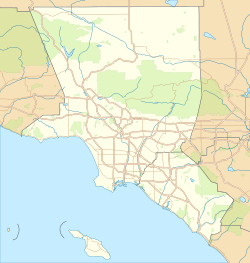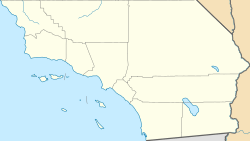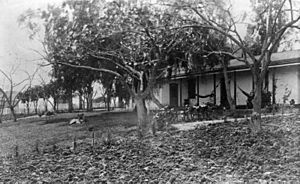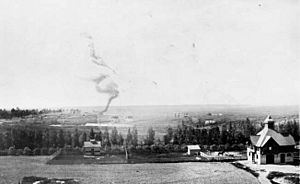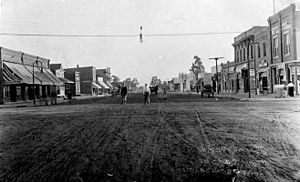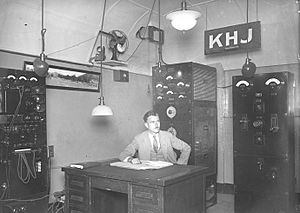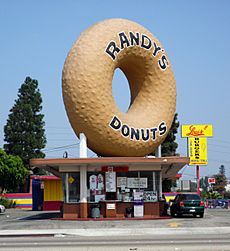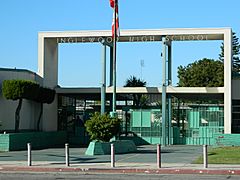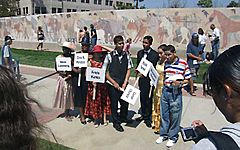Inglewood, California facts for kids
Quick facts for kids
Inglewood, California
|
|||
|---|---|---|---|

|
|||
|
|||
| Nickname(s):
"City of Champions"
|
|||
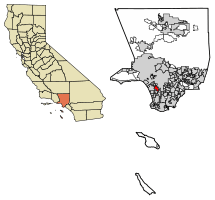
Location of Inglewood in Los Angeles County, California
|
|||
| Country | United States | ||
| State | California | ||
| County | Los Angeles | ||
| Established | 1888 | ||
| Incorporated | February 7, 1908 | ||
| Government | |||
| • Type | Council–Manager–Commission | ||
| Area | |||
| • Total | 9.09 sq mi (23.55 km2) | ||
| • Land | 9.07 sq mi (23.49 km2) | ||
| • Water | 0.03 sq mi (0.06 km2) 0.27% | ||
| Elevation | 131 ft (40 m) | ||
| Population
(2020)
|
|||
| • Total | 107,762 | ||
| • Rank | 12th in Los Angeles County 69th in California |
||
| • Density | 11,855/sq mi (4,575.9/km2) | ||
| Time zone | UTC−8 (Pacific) | ||
| • Summer (DST) | UTC−7 (PDT) | ||
| ZIP Codes |
90301–90312
|
||
| Area codes | 310,424, 213/323 | ||
| FIPS code | 06-36546 | ||
| GNIS feature IDs | 1660799, 2410106 | ||
Inglewood is a city in southwestern Los Angeles County, California, United States. It's part of the larger Los Angeles area. In 2020, about 107,762 people lived there. Inglewood is located in the South Bay region, close to Los Angeles International Airport. The city started growing after a railway opened in 1887 and became an official city on February 14, 1908.
Inglewood is a big center for professional sports. Many famous teams have played in its venues. The Kia Forum, an indoor arena, opened in 1967. It was home to the Los Angeles Lakers (basketball), Los Angeles Kings (hockey), and Los Angeles Sparks (women's basketball) until 1999. Since 2020, two National Football League teams, the Los Angeles Rams and Los Angeles Chargers, play at SoFi Stadium. This stadium will also host the opening and closing ceremonies for the 2028 Summer Olympics. The Los Angeles Clippers basketball team started playing at Intuit Dome in 2024.
Contents
History of Inglewood
Early Days and Spanish Influence
The very first people living in the Inglewood area were Native Americans. They used the natural springs in what is now Edward Vincent Jr. Park. These springs were called Centinela, meaning "sentinels" or "watchers," because of the hills around them. Ranchers used these hills to watch their animals.
The written history of Inglewood goes back to 1781. That's when Spanish soldiers, like Jose Manuel Orchado Machado, settled in Los Angeles. They were told to let their animals graze near the ocean, away from Mission lands. So, they brought their cattle to the green lands near Centinela Springs. The first building there was a corral and a hut built by Ygnacio Avila in 1822.
Later, Avila built a three-room adobe house overlooking a creek. This adobe is no longer there. In 1834, Ygnacio Machado built the Centinela Adobe. This historic building is now the home of the Centinela Valley Historical Society.
Inglewood in the American Era
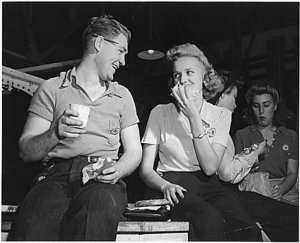
Over the years, Inglewood grew and changed a lot. Inglewood Park Cemetery, a large cemetery for the whole region, was started in 1905. The city was also home to the Hollywood Park Racetrack from 1938 to 2013, which was a top place for horse racing in the U.S.
The first soft serve ice cream chain in California, Fosters Freeze, began in Inglewood in 1946. Inglewood has been named an All-America City twice, in 1989 and 2009, for its great progress. On January 12, 2016, Inglewood was chosen as the new home for the Los Angeles Rams football team.
Changes in Population
In the 1960s, Inglewood began to see more diversity. In 1969, an organization called "Inglewood Neighbors" worked to help different groups of people live together.
Harold P. Moret became Inglewood's first black police officer in 1969. Later, Jimmy Lee Worsham became the second. James T. Butts, Jr., who was the seventh black officer, later became the first black Chief of Police in Santa Monica. In 2011, he returned to Inglewood and was elected as the city's fourth black mayor.
In 1970, a court ordered Inglewood schools to become desegregated. This meant students of all backgrounds could attend schools together. Loyd Sterling Webb became the first black person elected to the school board in 1971. In 1972, Curtis Tucker Sr. was appointed as the first black City Council member. Edward Vincent became Inglewood's first black mayor in 1983.
By 1990, the number of Hispanic residents in Inglewood had grown a lot. This was the biggest increase in the South Bay area. Many new families moved to Inglewood because housing was more affordable.
Geography and Landmarks
Location and Size
Inglewood covers about 9.1 square miles (23.5 square kilometers). Downtown Inglewood is about 4.15 miles (6.68 km) from Los Angeles International Airport (LAX).
Famous Landmarks

The Forum was built in 1967. It was designed to look like the ancient Roman Forum. For many years, The Forum was a major concert spot, hosting stars like Elvis Presley and Led Zeppelin. It was also the home of the NBA's Los Angeles Lakers and the NHL's Los Angeles Kings. In 1999, these teams moved to the Staples Center.
In 2012, The Forum was bought by The Madison Square Garden Company. They spent $50 million to make it a top concert venue again. It reopened in 2014 with performances by the Eagles. In 2022, it was renamed the "Kia Forum."
On February 24, 2015, the Inglewood City Council approved plans for a new NFL stadium. This stadium, now called SoFi Stadium, opened in 2020. It was built on a 60-acre plot of land that was part of the Hollywood Park development.
Community and People
Population Overview
Inglewood is a diverse city. In 2020, the city had a population of 107,762 people. About 50.67% of the population was Hispanic or Latino. About 40.96% were Black or African American.
The city has a relatively young population, with many families. In 2010, about 26.7% of the people were under 18 years old.
Homelessness in Inglewood
The Los Angeles Homeless Services Authority counts the number of people experiencing homelessness. In 2022, there were 751 homeless individuals counted in Inglewood.
Arts and Culture
Public Libraries
Inglewood has a main library in its Civic Center. There is also a branch library in the southeastern part of the city.
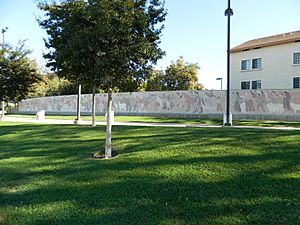
Music and Art
The Southeast Symphony Association is a non-profit group in Inglewood. It was started in 1948 to create an orchestra that welcomed African-American musicians.
The annual Open Studios event in Inglewood shows off local art, including drawings, paintings, and photography. This event is organized by artists with help from Inglewood Cultural Arts, Inc. (ICA).
Sports in Inglewood
Professional Sports Teams

Inglewood is home to the Los Angeles Rams and Los Angeles Chargers of the National Football League. They play their games at SoFi Stadium. This stadium hosted Super Bowl LVI in 2022 and will host Super Bowl LXI in 2027.
The Los Angeles Lakers (NBA) and Los Angeles Kings (NHL) played at the Kia Forum from 1967 to 1999. They then moved to Crypto.com Arena in Downtown Los Angeles.
On July 26, 2019, the Los Angeles Clippers (NBA) announced plans to build a new arena in Inglewood. This new arena, called Intuit Dome, opened in August 2024. It includes the arena, team offices, a training facility, and community spaces. Clippers owner Steve Ballmer also plans to invest $100 million into Inglewood for things like affordable housing and school programs.
| Club | League | Venue | Founded | Established in Inglewood |
Championships |
|---|---|---|---|---|---|
| Los Angeles Rams | National Football League | SoFi Stadium | 1936 (in Cleveland) | (2020 in Inglewood) | 4 (1 in Inglewood) (1 in Los Angeles Pre-1970 AFL–NFL merger) |
| Los Angeles Chargers | 1960 (in Los Angeles) | (2020 in Inglewood) | 1 (AFL Championship) | ||
| Los Angeles Clippers | National Basketball Association | Intuit Dome | 1970 (As the Buffalo Braves) | (1984 in Los Angeles, 2024 in Inglewood) | 0 |
Past Teams
Inglewood was also the former home of the Los Angeles Lakers (NBA) and the Los Angeles Kings (NHL) from 1967 to 1999. The Los Angeles Sparks (WNBA) played there from 1997 to 2000. All these teams later moved to Crypto.com Arena.
| Club | League | Venue | Founded | Established in Inglewood |
Departed Inglewood |
Championships |
|---|---|---|---|---|---|---|
| Los Angeles Lakers | National Basketball Association | Kia Forum | 1947 (in Minneapolis) | (1967 in Inglewood) | 1999 | 17 (6 in Inglewood) (5 in Minneapolis, 6 after departure from Inglewood) |
| Los Angeles Kings | National Hockey League | Kia Forum | 1967 | (1967 in Inglewood) | 1999 | 2 (2 after departure from Inglewood) |
| Los Angeles Sparks | Women's National Basketball Association | Kia Forum | 1997 | (1997 in Inglewood) | 2000 | 3 (3 after departure from Inglewood) |
Olympic and World Cup Events
Inglewood has hosted major international sports events. At the 1984 Summer Olympics, The Forum hosted basketball games. For the 2028 Summer Olympics, SoFi Stadium will host the opening and closing ceremonies, as well as swimming events. Archery will be held in Lake Park next to the stadium. Intuit Dome will host all the basketball events.
SoFi Stadium will also host several matches for the 2026 FIFA World Cup.
Education in Inglewood
Most of Inglewood is served by the Inglewood Unified School District. This district has two main high schools: Inglewood High School and Morningside High School. It also has City Honors High School and an alternative school. Some parts of Inglewood are in the Los Angeles Unified School District.
There are also public charter schools like Ánimo Inglewood Charter High School. Private schools include St. John Chrysostom Elementary School (a Catholic school) and St. Mary's Academy.
School History
In 1888, the first school in Inglewood opened on the second floor of a stable. It had 33 students. A permanent school building was built later that year. It was Inglewood's only school until 1911 and was destroyed by an earthquake in 1920.
The Centinela Valley Union High School District was formed in 1904 to provide high school education. Inglewood High School opened in 1904 with 15 students. In 1913, George M. Green became the principal and stayed for many years.
In 1914, new buildings were added to the high school, including a "Home Economics Building" with a model apartment. The school also had "The Farm," an area for agricultural studies. In 1915, Inglewood High was recognized for its beautiful buildings.
In the 1920s, the high school district was very large. In 1932, the grammar school was renamed Crozier School after its long-time principal, George W. Crozier. In 1952, another high school, Morningside High School, opened in Inglewood.
Media and Filming
Media Companies
Hollywood Park in Inglewood is home to NFL Media. This includes NFL Network, NFL RedZone, and NFL.com. These offices moved from Culver City to be next to SoFi Stadium.
The TV network Showtime also has offices in Inglewood, near LAX.
Filming Locations
Inglewood has been a setting for several movies and TV shows:
- Inglewood City Hall: The inside of City Hall was used as the headquarters for the TV show The New Adventures of Wonder Woman. It was also the coroner's office in the 1970s TV show Quincy, M.E.
- The Wood: This 1999 movie is about three African-American men remembering their childhood in Inglewood in the 1980s.
City Services
Transportation
Streets and Highways
Many major streets run through Inglewood, such as La Cienega Boulevard, Crenshaw Boulevard, Hawthorne Boulevard (California), and Florence Avenue. Two major freeways serve the city: Interstate 405 and Interstate 105 (California).
Public Transportation
The city is served by the K Line of the Los Angeles Metro Rail system. There are three stations in Inglewood: Fairview Heights, Downtown Inglewood, and Westchester/Veterans station. The city is also planning the Inglewood Transit Connector. This will be an automated system to connect the sports and entertainment venues to the downtown rail station.
In 1887, a train station was built in Inglewood. This was the end of the Ballona railroad line from Los Angeles. The train line helped connect Inglewood to other areas, including Redondo Beach.
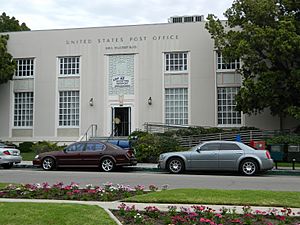
Fire Department
Fire protection for Inglewood is provided by the Los Angeles County Fire Department.
Famous People from Inglewood
Many notable people have connections to Inglewood:
Born in Inglewood
- Tyra Banks, a famous fashion model and TV personality.
- Becky G, an actress and singer.
- Swae Lee, a popular rapper.
- Omarion, an R&B singer and actor.
- Brittney Reese, an Olympic and World champion in long jump.
- D Smoke, a musician.
- Brian Wilson, a musician and songwriter from The Beach Boys.
Other Residents
- Sonny Bono, a singer, actor, and politician.
- Lisa Leslie, a retired WNBA basketball player.
- Paul Pierce, a retired NBA basketball player.
Sister Cities
Inglewood has special connections with other cities around the world, called "sister cities":
 Bo, Sierra Leone
Bo, Sierra Leone Pedavena Veneto, Italy
Pedavena Veneto, Italy Port Antonio, Jamaica
Port Antonio, Jamaica Ringwood, Victoria, Australia
Ringwood, Victoria, Australia Tijuana, Baja California, Mexico
Tijuana, Baja California, Mexico
Images for kids
-
Aircraft workers on lunch break in Inglewood aircraft factory of North American Aviation, 1942.
See also
 In Spanish: Inglewood (California) para niños
In Spanish: Inglewood (California) para niños




